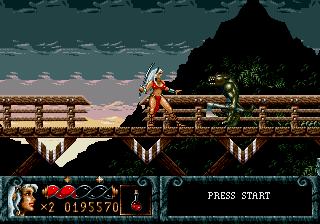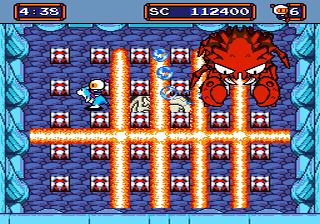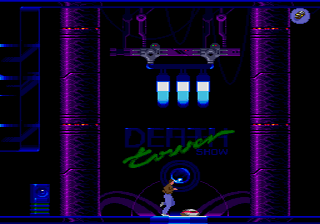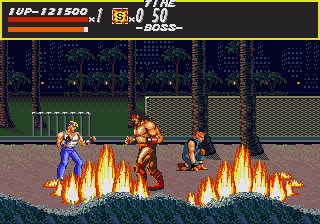April’s a slow month, as winter finally gets lost and lets spring back in the house. With sunshine and green grass, people tend to neglect their poor video games for trivial things like fresh air and exercise. That’s OK; the games will still be there when they get back. Our staff and readers have been playing some gems this month, in between bouts of the need for this thing called “outside.” Read on and see what we’ve been up to!
Blades of Vengeance By Ken Horowitz
 I don’t think there’s a hack-and-slasher on the Genesis that compares to the original Golden Axe, but there sure are some that come close. EA provided us with this little gem, and for the most part it flew completely under my radar. I’d seen it at the rental store back in the day, but I never got around to playing it until my minty copy arrived in the mail. To be honest, I was really impressed.
I don’t think there’s a hack-and-slasher on the Genesis that compares to the original Golden Axe, but there sure are some that come close. EA provided us with this little gem, and for the most part it flew completely under my radar. I’d seen it at the rental store back in the day, but I never got around to playing it until my minty copy arrived in the mail. To be honest, I was really impressed.
Blades of Vengeance mixes solid gameplay with good presentation. I really like how the characters (a total of three) handle, and the game looks very nice in s-video. I’d have liked some more parallax scrolling (don’t I say that about every game?) , but the visuals are really quite nice. The music… well, it gets the job done, but it’s no threat to Sega’s golden achiever.
That’s fine with me though, as I’ve come to consider Blades of Vengeance as a compliment to those titles instead of competition. They’re not the same type of game, really, as Blades focuses more on exploration than straight-up action. There’s plenty of room in my library for both, and I intend to keep at this one until I see the end credits. You should do the same.
Mega Bomberman By Sebastian Sponsel
 It’s tournament season again! Almost exactly one year after the last event, May 10th 2014 will mark the eighth time that the German Mega Drive Championships will commence. While this year will once more see some Minor changes (like the reintroduction of the puzzle category for instance), it’s good to see that certain elements are so popular that they can already be considered to essentially be tradition. As such, once more Mega Bomberman was elected by tournament participants to be the inaugural Game of the event.
It’s tournament season again! Almost exactly one year after the last event, May 10th 2014 will mark the eighth time that the German Mega Drive Championships will commence. While this year will once more see some Minor changes (like the reintroduction of the puzzle category for instance), it’s good to see that certain elements are so popular that they can already be considered to essentially be tradition. As such, once more Mega Bomberman was elected by tournament participants to be the inaugural Game of the event.
Can’t say I’m surprised, really. This game is a blast (pun intended)! Blowing up your opponents in a -our-way free-for-all extravaganza provides just the right mix of action, strategy, and schadenfreude that not only provides great gameplay but also loads of fun for the spectators as well. Oh, the dramatic moments that we’ve seen. certain victories snatched away at the fraction of a second because someone accidentally touched a skull and switched places with his victim caught in a deathtrap. Great split-second timing with bombs being kicked into blasts just at the right moment. Brilliant strategies in trapping other players, perfectly utilizing bombs, the environment and the block-kicking abilities of the yellow kangaroo. Or the screams of surprises during last years semifinal when One player literally managed to leap out of certain doom.
I can’t wait to see what surprises await this year!
Flashback: The Quest for Identity By The Coop
From back before the 8-bit era was being ruled by the NES, to when the 16-bit era was getting in full swing, console games occasionally had these neat little things called cinemas. These combinations of sprites and text were meant to drive a game’s story forward in some way; be it through a simple opening to set the mood, or something more in-depth to create or expand a plot point. They weren’t present in every game, and some of the ones that did use them, did so in a less than stellar manner (like Valis: The Phantasm Soldier on the Genesis, and its painfully slow cinema text). But there were some games that put such things to good use. And with 1993’s Flashback: The Quest For Identity, the Genesis got a game that really welcomed cinemas to a new level on the system.
The game features a mixture of rotoscoped polygon characters, over top of sprite-based backgrounds. With nicely detailed scenery and extremely smooth animation, the game already had a solid and impressive visual style. Factor in an interesting story to unfold, action and puzzle-based gameplay, and a good level of challenge, and the game was a classic in the making. But what also helped the game make a name for itself, were the cinemas. Made up of polygonal, rotoscoped shapes and figures, the stiff and choppy sprite-based stuff we’d become so used to with the NES and Master System were gone; replaced with smooth action and movement that truly did feel more cinema-like. But this game was made for the Amiga first in 1992. And like DOS gamers, Amiga users were used to seeing come pretty snazzy cinemas coming out of their computer. But with the tag line of “The CD ROM game in a cartridge” put on the back of the clamshell case, the people who ported the game to SEGA’s 16-bitter let players know that their Genesis cart lost very little in the porting process. Yes, the Genesis port was very faithful to the Amiga original in terms of visuals. The opening and ending were there, the little cinemas scattered throughout were still there, and the movie-like feel these bits added to the game’s already cinematic visual style was fully intact.
But this game was made for the Amiga first in 1992. And like DOS gamers, Amiga users were used to seeing come pretty snazzy cinemas coming out of their computer. But with the tag line of “The CD ROM game in a cartridge” put on the back of the clamshell case, the people who ported the game to SEGA’s 16-bitter let players know that their Genesis cart lost very little in the porting process. Yes, the Genesis port was very faithful to the Amiga original in terms of visuals. The opening and ending were there, the little cinemas scattered throughout were still there, and the movie-like feel these bits added to the game’s already cinematic visual style was fully intact.
Now, that’s not to say that the Genesis didn’t get some fantastic cinemas before Flashback came about. We had the likes of M.U.S.H.A. and Arcus Odyssey with great sprite-based openings, and the memorable opening of Out Of This World as well. We also got games like El Viento that featured little cinemas scattered throughout the entire game, and titles like Alisia Dragoon and Valis III that had sizable, well done endings. But Flashback took what Out Of This World gave the Genesis players a taste of with its opening and (really brief) ending, and expanded on it to create a game with equally impressive cinemas, and more of them. It wasn’t just text and an image or two anymore, as even a quick three second cinematic for picking something up had more impact thanks to the new style. Yet the game makers didn’t go overboard like Square-Enix would eventually do with a maniacal glee. Delphine Software International struck that balance of pinpointing an important moment or object, while still letting the gameplay rule the roost. And when it was called for, the game delivered a bigger cinema that kept the player glued to the TV until it was over.
So yeah, cinemas, man. Openings, endings, mid-game cut scenes… we take them for granted today, and sometimes even grow sick of them showing up thanks to some companies going utterly apeshit with them (and their QTE offspring). But back in the early ’90s, they were welcomed by many gamers, and really looked forward to when handled well like in some of the games I mentioned. And while credit must be given to Out Of This World for how it gave Genesis owners an introduction to cinemas done in that smooth, rotoscoped style, I think that style’s greater presence within Flashback: The Quest For Identity hammered home just how cool they really were for the time.
Streets of Rage by Frank Villone
The brawler genre was something I could only daydream about during the Genesis’ original lifetime, when I could only get a hold of a small handful of games! Seeing screen-shots of Streets of Rage 2 (in magazines, or on the back of the Genesis cardboard box), I would imagine how amazing it would be to fight in the rain!
 Years later, it would turn out that yes, it is indeed amazing to fight in the rain! Streets of Rage 2 will always be the greatest brawler in my eyes! I had never given the first title much time before now, but it turned out to be surprisingly great as well! Although sprites are smaller and less-detailed than its famous sequel, here they are still well-drawn and animated! Each character controls nicely, as the streets are just raging the hell out! Punches, kicks, throws, and jump-kicks are flying everywhere! Not to mention shattering glass bottles, pipes, bats, knives, and smoke bombs!
Years later, it would turn out that yes, it is indeed amazing to fight in the rain! Streets of Rage 2 will always be the greatest brawler in my eyes! I had never given the first title much time before now, but it turned out to be surprisingly great as well! Although sprites are smaller and less-detailed than its famous sequel, here they are still well-drawn and animated! Each character controls nicely, as the streets are just raging the hell out! Punches, kicks, throws, and jump-kicks are flying everywhere! Not to mention shattering glass bottles, pipes, bats, knives, and smoke bombs!
And of course, each life (up to the last stage) allows for one use of this title’s signature special move: Pressing A for the screen to scroll wildly left and right, as a cop car appears to fire upon the entire screen at once! This creates a kind of rhythm to the gameplay as the lives drain by inevitably, and so the special attack gets used every couple minutes.
Dust has been settling from some real-life chaos, mainly based on having to suddenly move again unexpectedly! Oh well! In the realm of Sega, the original Streets of Rage filled the last weeks in my studio apartment with awesome fighting action and Yuzo Koshiro’s fantastic soundtrack! What an awesome stress-release, especially during chaotic times of life! While it may be destined to be eclipsed forever by its sequel, Streets of Rage still stands on its own!

Recent Comments